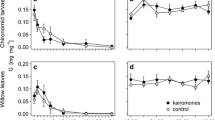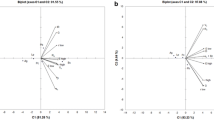Summary
In laboratory experiments, the predator, Notonecta glauca L., was exposed to varying densities of surfacedwelling culicine mosquito larvae and the bottom-inhabiting isopod, Asellus aquaticus L., in either shallow or deep water at 20° C. At this temperature N. glauca spends most of the time at the water's surface, so, by changing water depth the accessibility of Asellus to the predator was manipulated relative to a consistent Culex presence.
All N. glauca spent more time submerged in shallow (75 mm) than in deep (275 mm) water but submergence times were independent of exposure to different prey combinations. Mature females made more descents and remained submerged longer than males.
All N. glauca captured more Asellus in shallow than in deep water but males and newly-moulted females captured Culex predominantly, in all treatments, regardless of water depth or prey availability. Mature females captured mostly Asellus in shallow water and Culex in deep water. When presented with small rather than large Asellus, mature females spent an equivalent amount of time submerged as in the large Asellus treatments and ate the same number of Asellus but more Culex.
By foraging on Culex larvae, male and newly moulted female N. glauca maximise their rate of energy intake. In contrast, mature females may actively select Asellus to optimise something other than energy (e.g. specific nutrients). Alternatively their predation on Asellus may be simply a consequence of a high encounter rate with this prey type, reflecting habitat use determined by factors that do not concern prey capture directly.
Similar content being viewed by others
References
Alexander R, McNeil (1971) Animal mechanics. Sidgwick & Jackson, London
Charnov EL (1976) Optimal foraging: attack strategy of a mantid. Am Nat 110:141–151
Cockrell BJ (1980) A study of predation by Notonecta glauca (L.). Unpublished D. Phil. thesis, University of Oxford
Cockrell BJ (1984) Effects of temperature and oxygenation on predator-prey overlap and prey choice of Notonecta glauca. J Anim Ecol (in press)
Cook RM, Hubbard SF (1977) Adaptive searching strategies in insect parasites. J Anim Ecol 46:116–125
Cummins KW, Wuycheck JC (1971) Caloric equivalents for investigations in ecological energetics. Int Ver Theor Angew Limnol Verh 18:1–158
Emlen JM, Emlen MGR (1975) Optimal choice in diet: test of an hypothesis. Am Nat 109:427–435
Giller PS (1979) The predation strategies and bionomics of three species of Nontonecta (Heteroptera/Hemiptera). Unpublished Ph.D. Thesis. University of London
Goss-Custard JD (1977) Optimal foraging and the size selection of worms by redshank Tringa totanus. Anim Behav 25:10–29
Greenberg B (1959) Housefly nutrition. 1. Quantitative study of the protein and sugar requirements of males and females. J Cell Comp Physiol 53:169–177
Griffiths KJ (1969) The importance of coincidence in the functional and numerical responses of two parasites of the European pine sawfly, Neodiprion sertifer. Can Entomol 101:673–713
Hassell MP, May RM (1974) Aggregation of predators and insect parasites and its effect on stability. J Anim Ecol 43:567–594
Hassell MP, Southwood TRE (1978) Foraging strategies of insects. Ann Rev Ecol Syst 98:75–98
House HL (1974) Nutrition. In: Rockstein, M (ed) The Physiology of Insecta, Vol. 5, Academic Press, London New York, pp 1–53
Hubbard SF, Cook RM (1978) Optimal foraging by parasitoid wasps. J Anim Ecol 47:593–604
Jaeger RG, Barnard DE (1981) Foraging tactics of a terrestrial salamander: choice of diet in structurally simple environments. Am Nat 117:639–664
Kislalioglu M, Gibson RN (1976) Some factors governing prey selection by the 15-spined stickleback, Spinachia spinachia (L.). J Exp Mar Biol Ecol 25:159–169
Krebs JR (1978) Optimal foraging: decision rules for predators. In: Krebs JR, Davies NB (eds) Behavioural Ecology: an Evolutionary Approach, Blackwell Scientific Publications, Oxford, pp 23–63
Milinski M, Heller R (1978) Influence of a predator on the optimal foraging behaviour of sticklebacks (Gasteroteus aculeatus). Nature 275:642–644
Murdoch WW (1969) Switching in general predators: experiments on predator specificity and stability of prey populations. Ecol Monogr 39:335–354
Murdoch WW, Avery S, Smith MEB (1975) Switching in predatory fish. Ecology 56:1094–1105
Popham EJ (1962) A repetition of Ege's experiments and a note on the efficiency of the physical gill of Notonecta (Hemiptera-Heteroptera). Proc Roy Ent Soc Lond (A) 37:154–160
Pulliam HR (1975) Diet optimisation with nutrient constraints. Am Nat 109:765–768
Pyke GH, Pulliam HR, Charnov EL (1977) Optimal foraging: a selective review of theory and tests. Q Rev Biol 52:137–154
Rovama T (1970) Factors governing the hunting behaviour and selection of food by the great tit (Parus major L.). J Anim Ecol 39:619–668
Sih A (1980) Optimal behaviour: can foragers balance two conflicting demands? Science 210:1041–1042
Southwood TRE, Leston D (1959) Land and water bugs of the British Isles. Warne & Co. London
Strangways-Dixon J (1961) The relationship between nutrition, hormones and reproduction in the blowfly Calliphora erythrocephala (Meig.).1. Selective feeding in relation to the reproductive cycle, the corpus allatum volume and fertilization. J Exp Biol 38:225–235
Ware D (1973) Risk of epibenthic prey to predation by the rainbow trout (Salmo gairdneri). J Fish Res Bd Can 30:787–797
Werner EE, Hall DJ (1974) Optimal foraging and the size selection of prey by the Bluegill Sunfish (Lepomis macrochirus). Ecology 55:1216–1232
Werner EE, Mittleback GG (1981) Optimal foraging: field tests of diet choice and habitat switching. Amer Zool 21:813–829
Author information
Authors and Affiliations
Rights and permissions
About this article
Cite this article
Cockrell, B.J. Effects of water depth on choice of spatially separated prey by Notonecta glauca L.. Oecologia 62, 256–261 (1984). https://doi.org/10.1007/BF00379023
Received:
Issue Date:
DOI: https://doi.org/10.1007/BF00379023




